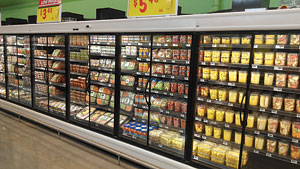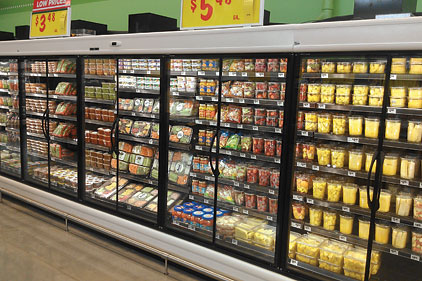While supermarkets were first to make the shift from ozone depletion potential (ODP) refrigerants like chlorofluorocarbons (CFCs) and hydrochlorofluorocarbons (HCFCs) to the now commonplace hydrofluorocarbons (HFCs), the next step beyond f-gases is not as clear cut.

|
| Propane is now being introduced as a refrigerant to provide the cooling needed to maintain proper product temperature in display cases. |
The phaseout of CFCs in the 1990s initially had store decision makers trying HCFCs in medium- and low-temperature applications — but moving to quickly embrace HFCs, with R-404 and R-507 being the most commonly used.
Now HFCs dominate the sector. CFCs are almost totally gone, as antiquated equipment is replaced. And many HCFC systems are being retrofitted with HFCs.
But, on the horizon are the so-called natural refrigerants. They are being promoted as non-ozone-depleting, with little to no effect on global warming. For some advocates, they are considered environmentally correct alternatives to HFCs. To others, they are viewed as energy efficient and cost effective as HFCs. Measurements in real-world applications are continually pouring in, offering more evidence of the potential impact — or lack thereof — that these so-called natural refrigerants possess.
Propane
Hydrocarbons (HCs) such as propane (R-290) have been around for a long time and are used in residential refrigerators in Europe. Now, R-290 is showing broader use in supermarket display cases, including a new 83,000-square-foot store in Austin, Texas.
“Our ultimate goal with this project is a 70 percent energy reduction from all the store systems,” said Charlie Wernette, director of engineering for H.E. Butt Grocery Co. (H-E-B). “We believe that an R-290 system will achieve approximately 50 percent energy reduction compared to our typical store refrigeration load. Based on the tests and analysis we have conducted to date, we believe that the actual sustainability and energy reductions will far exceed any measurement used today by LEED and GreenChill.”
Phil Evans Sr., vice president of engineering, Hussmann Corp., said, “When H-E-B approached Hussmann about wanting to use propane for the Austin Mueller store, we were very excited about working with them in the development, design, and installation of this alternate refrigerant source for their store,” he said. “We have designed and engineered a propane system that will enable them to achieve their energy-reduction goals while maintaining a safe, shopper-friendly environment.”
The project factored in current U.S. Environmental Protection Agency (EPA) limitations on use of propane. According to Norm Street, director of new technologies, Hussman Corp., the process involved “methods (that) secured timely design validation, risk assessment, and approvals that met or exceeded H-E-B’s expectations. In view of the fact that we were using propane, safety was always our top priority — from the store personnel, to the customers in the store, as well as the perishables in the refrigerated display merchandisers.”
In that regard, self-contained refrigerated display cases are used throughout the store in order to comply with the lower charge requirements of the EPA’s Significant New Alternative Program (EPA-SNAP), according to a statement from Tecumseh Products Co. Tecumseh representatives said that over 40 percent of the display cases and walk-in coolers that utilize Tecumseh condensing units are equipped with the company’s all-new AE2 Series high-efficiency compressor.
“We are fully supportive of Hussmann and H-E-B Grocery Stores in their move to environmentally friendly hydrocarbon refrigerants,” said Jeff Fordeck, vice president of sales and marketing, North America, Tecumseh. “While this project had its challenges, the resourcefulness and expertise of Tecumseh and Hussmann personnel are what ultimately contributed to the successful refrigeration system design.”
Ammonia
Advocates of ammonia continue to promote its use in smaller applications rather than large industrial refrigeration sites, but getting it used in such locales means working through regulatory issues in terms of safety. So in the meantime, the industry looks at ways to use ammonia in supermarkets in conjunction with another refrigerant which lowers the amount of ammonia at the site — thus lowering its rating below regulatory requirements.
One of the recent projects in this regard was a 60,000-square-foot distribution warehouse in Montreal. Reducing ammonia charge was just one aspect of the project, which also required lower annual operating and maintenance costs.
Ammonia for medium-temperature refrigeration was the primary refrigerant to cool a single loop of recirculated CO2. The project was a joint effort of Danfoss and Cimco Refrigeration.
Another development involved a freezer installation in which a low-charge ammonia package was offered with an aluminum heat exchanger and low-pressure receiver system. The packaged plug-and-play ammonia systems are now available with a refrigerant charge as low as 0.8 pounds per ton of refrigeration (TR) for water chilling applications and 7 pounds/TR for freezer applications, according to Star Refrigeration of Scotland.
CO2
CO2 has been — by far — the most dominant non-f-gas refrigerant utilized in supermarkets. Dozens are springing up in the U.S. and hundreds are up and running in Canada and Europe. As noted previously, it is being used in conjunction with ammonia to lower ammonia charges. Ammonia is also being used in conjunction with HFCs to reduce the amount of f-gas needed on site — resulting in a corresponding cost reduction. And CO2 is gaining ground as a stand-alone refrigerant in transcritical systems.
The inroads in South America were marked this past June with a presentation in Vienna, Austria, at an Atmosphere Technology Summit. Carlos Arruda, consultant and foreign representative of Verdemar Supermarket of Brazil, noted a store using a CO2 cascade refrigeration system in conjunction with HFC-134a, which at the time of installation in 2010 was the first such example in South America. He said it was a collaborative project of Bitzer Brazil, Arneg, Danfoss, and Plotter & Racks.
The technology used R-134a in the primary circuit and CO2 in the secondary in a DX system for low-temperature applications. Propylene glycol was in the secondary circuit in medium-temperature applications. He said there were small motors and large evaporators with no defrosting. Frequency control marked the compressors, with dual-speed electronically commutated motors (ECMs) for preparation rooms, and variable-speed ECMs at the condenser. Other aspects included humid adiabatic condensation grids and electronic expansion valves.
He said this design became the standard for the supermarket chain and two more stores have since been built with the technology.
He said the approach is catching on in other parts of South America based on the stores’ track record.
Publication date: 9/9/2013
Want more HVAC industry news and information? Join The NEWS on Facebook, Twitter, and LinkedIn today!



Report Abusive Comment